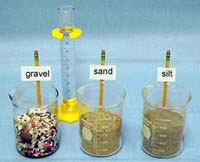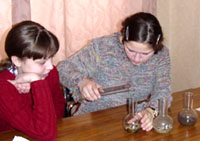Experiment: Porosity
 Solid rock is often not so solid. Sandstone might have started out as a sand dune or a beach, which got buried and compressed. But spaces remain between the particles. These spaces, or pores, are where oil and gas may be found.
Solid rock is often not so solid. Sandstone might have started out as a sand dune or a beach, which got buried and compressed. But spaces remain between the particles. These spaces, or pores, are where oil and gas may be found.
If you look at a sponge you can see many open spaces. Sandstone is like that, only the spaces are generally much smaller, so small that they cannot be seen without a microscope.
How much open space is there in rock? In this experiment we check the porosity of gravel, sand and silt, the raw materials that sandstone is made of.
Tools & Materials
- Gravel, sand and silt
- 3 beakers, 500 milliliters each
- A 100ml graduated cylinder
- Water
 Students at Experiment Research Center School in Russia experimenting with porosity. |
The Experiment
- Fill one beaker to the 350ml mark with gravel, the second beaker with 350ml of sand and the third with 350ml of silt.
- Fill the graduated cylinder to the 100ml mark with water.
- Slowly and carefully pour the water into the first beaker until the water just reaches the top of the gravel. Record exactly how much water you use. If you need more than 100ml of water, fill the graduated cylinder again.
- Follow step 3 again for the beaker with sand, and again for the beaker with silt.
Calculating Porosity:
For each material, calculate the porosity by dividing the volume of water that you were able to pour into it by the total volume of the material. Then express this result as a percentage. For example If you were able to add 90ml of water to 350ml of gravel, the porosity would be
90 ml
----------- = .2571 = 25.71%
350 ml
Use the chart below to record your data and calculations. There are extra spaces if you want to try this with some other materials.
|
|
|
(pore space) |
% Pore Space
|
|
gravel |
|
|
|
|
sand |
|
|
|
|
silt |
|
|
|
|
|
|
|
|
|
|
|
|
|
|
|
|
|
|
After you've tried this you might want to have a look at our results [1].
This content has been re-published with permission from SEED. Copyright © 2025 Schlumberger Excellence in Education Development (SEED), Inc.
Course:
- Science [3]
- earth science [4]
